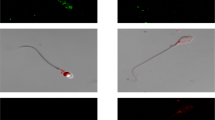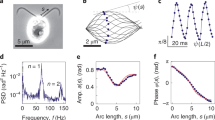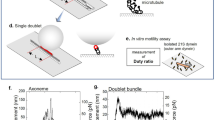Abstract
The signalling pathway and the behavioural strategy underlying chemotaxis of sperm are poorly understood. We have studied the cellular events and motor responses that mediate chemotaxis of sperm from the sea urchin Arbacia punctulata. Here we show that resact, a chemoattractant peptide, initiates a rapid and transient rise in the concentration of cyclic GMP, followed by a transient influx of Ca2+. The binding of a single resact molecule elicits a Ca2+ response, and 50–100 bound molecules saturate the response. The ability to register single molecules is reminiscent of the single-photon sensitivity of rod photoreceptors. Both resact and cyclic nucleotides cause a turn or brief tumbling in the swimming path of sperm. We conclude that a cGMP-mediated increase in the Ca2+ concentration induces the primary motor response of sperm to the chemoattractant.
This is a preview of subscription content, access via your institution
Access options
Subscribe to this journal
Receive 12 print issues and online access
$209.00 per year
only $17.42 per issue
Buy this article
- Purchase on Springer Link
- Instant access to full article PDF
Prices may be subject to local taxes which are calculated during checkout








Similar content being viewed by others
References
Cosson, M.P. in Controls of Sperm Motility: Biological and Clinical Aspects (ed. Gagnon, C.) 103–135 (CRC, Boca Raton, FL, 1990).
Eisenbach, M. Sperm chemotaxis. Rev. Reprod. 4, 56–66 (1999).
Miller, R.L. in Biology of Fertilization, Vol. 2: Biology of the Sperm (eds Metz, C.B. & Monroy, A.) 275–337 (Academic, New York, 1985).
Eisenbach, M. & Tur-Kaspa, I. Do human eggs attract spermatozoa? BioEssays 21, 203–210 (1999).
Garbers, D.L. Molecular basis of fertilization. Annu. Rev. Biochem. 58, 719–742 (1989).
Suzuki, N. Structure, function and biosynthesis of sperm-activating peptides and fucose sulfate glycoconjugate in the extracellular coat of sea urchin eggs. Zool. Sci. 12, 13–27 (1995).
Ward, C.R. & Kopf, G.S. Molecular events mediating sperm activation. Dev. Biol. 158, 9–34 (1993).
Darszon, A., Labarca, P., Nishigaki, T. & Espinosa, F. Ion channels in sperm physiology. Physiol. Rev. 79, 481–510 (1999).
Cook, S.P. & Babcock, D.F. Activation of Ca2+ permeability by cAMP is coordinated through the pHi increase induced by speract. J. Biol. Chem. 268, 22408–22413 (1993).
Cook, S.P. & Babcock, D.F. Selective modulation by cGMP of the K+ channel activated by speract. J. Biol. Chem. 268, 22402–22407 (1993).
Cook, S.P., Brokaw, C.J., Muller, C.H. & Babcock, D.F. Sperm chemotaxis: egg peptides control cytosolic calcium to regulate flagellar responses. Dev. Biol. 165, 10–19 (1994).
Darszon, A., Beltrán, C., Felix, R., Nishigaki, T. & Treviño, C.L. Ion transport in sperm signaling. Dev. Biol. 240, 1–14 (2001).
Bookbinder, L.H., Moy, G.W. & Vacquier, V.D. Identification of sea urchin sperm adenylate cyclase. J. Cell Biol. 111, 1859–1866 (1990).
Bookbinder, L.H., Moy, G.W. & Vacquier, V.D. In vitro phosphorylation of sea urchin sperm adenylate cyclase by cyclic adenosine monophosphate-dependent protein kinase. Mol. Reprod. Dev. 28, 150–157 (1991).
Beltrán, C., Zapata, O. & Darszon, A. Membrane potential regulates sea urchin sperm adenylylcyclase. Biochemistry 35, 7591–7598 (1996).
Nishigaki, T., Zamudio, F.Z., Possani, L.D. & Darszon, A. Time-resolved sperm responses to an egg peptide measured by stopped-flow fluorometry. Biochem. Biophys. Res. Commun. 284, 531–535 (2001).
Schackmann, R.W. & Chock, P.B. Alteration of intracellular [Ca2+] in sea urchin sperm by the egg peptide speract. J. Biol. Chem. 261, 8719–8728 (1986).
Shimomura, H. & Garbers, D.L. Differential effects of resact analogues on sperm respiration rates and cyclic nucleotide concentrations. Biochemistry 25, 3405–3410 (1986).
Nishigaki, T. & Darszon, A. Real-time-measurements of the interactions between fluorescent speract and its sperm receptor. Dev. Biol. 223, 17–26 (2000).
Lamb, T.D., McNaughton, P.A. & Yau, K.-W. Spatial spread of activation and background desensitization in toad rod outer segments. J. Physiol. (Lond.) 319, 463–496 (1981).
Ward, G.E., Brokaw, C.J., Garbers, D.L. & Vacquier, V.D. Chemotaxis of Arbacia punctulata spermatozoa to resact, a peptide from the egg jelly layer. J. Cell Biol. 101, 2324–2329 (1985).
Brokaw, C.J., Josslin, R. & Bobrow, L. Calcium ion regulation of flagellar beat symmetry in reactivated sea urchin spermatozoa. Biochem. Biophys. Res. Commun. 58, 795–800 (1974).
Ho, H.C. & Suarez, S.S. Hyperactivation of mammalian spermatozoa: function and regulation. Reproduction 122, 519–526 (2001).
Babcock, D.F., Bosma, M.M., Battaglia, D.E. & Darszon, A. Early persistent activation of sperm K+ channels by the egg peptide speract. Proc. Natl Acad. Sci. USA 89, 6001–6005 (1992).
Gauss, R., Seifert, R. & Kaupp, U.B. Molecular identification of a hyperpolarization-activated channel in sea urchin sperm. Nature 393, 583–587 (1998).
Pugh, E.N. Jr. & Lamb, T.D. in Handbook of Biological Physics (eds Stavenga, D.G., DeGrip, W.J. & Pugh, E.N Jr) 183–255 (Elsevier Science, Amsterdam, The Netherlands, 2000).
Gray-Keller, M., Denk, W., Shraiman, B. & Detwiler, P.B. Longitudinal spread of second messenger signals in isolated rod outer segments of lizards. J. Physiol. (Lond) 519, 679–692 (1999).
Grynkiewicz, G., Poenie, M. & Tsien, R.Y. A new generation of Ca2+ indicators with greatly improved fluorescence properties. J. Biol. Chem. 260, 3440–3450 (1985).
Hagen, V., et al. Highly efficient and ultrafast phototriggers for cAMP and cGMP by using long-wavelength UV/Vis-activation. Angew. Chem. Int. Ed. 40, 1046–1048 (2001).
Hagen, V., Frings, S., Bendig, J., Lorenz, D., Wiesner, B. & Kaupp, U.B. Fluorescence spectroscopic quantification of the release of cyclic nucleotides from photocleavable [Bis(carboxymethoxy)coumarin-4-yl]methyl esters inside cells. Angew. Chem. Int. Ed. 41, 3625–3628 (2002).
Tatsu, Y., Nishigaki, T., Darszon, A. & Yumoto, N. A caged sperm-activating peptide that has a photocleavable protecting group on the backbone amide. FEBS Lett. 525, 20–24 (2002).
Acknowledgements
We thank members of the Kaupp laboratory for reading the manuscript and discussions; H.-D. Grammig for making the figures; and A. Eckert for preparing the manuscript. This work was supported by the Deutsche Forschungsgemeinschaft.
Author information
Authors and Affiliations
Corresponding author
Supplementary information
Supplementary Figures
Figure S1 Changes in [Ca2+]i in sperm stimulated by resact in the presence of 0.5 mM IBMX. (PDF 344 kb)
Figure S2 Accumulation of sperm in an area (rectangular field) of photolysed caged resact (10 μM). cells entering the area of released resact (20 ms intervals between consecutive
Figure S3 Models of Chemotactic Signaling.
Rights and permissions
About this article
Cite this article
Kaupp, U., Solzin, J., Hildebrand, E. et al. The signal flow and motor response controling chemotaxis of sea urchin sperm. Nat Cell Biol 5, 109–117 (2003). https://doi.org/10.1038/ncb915
Received:
Accepted:
Published:
Issue Date:
DOI: https://doi.org/10.1038/ncb915
This article is cited by
-
The solute carrier SLC9C1 is a Na+/H+-exchanger gated by an S4-type voltage-sensor and cyclic-nucleotide binding
Nature Communications (2018)
-
3D imaging of sex-sorted bovine spermatozoon locomotion, head spin and flagellum beating
Scientific Reports (2018)
-
Microfluidics for sperm analysis and selection
Nature Reviews Urology (2017)
-
Natriuretic peptide type C induces sperm attraction for fertilization in mouse
Scientific Reports (2017)
-
Network model predicts that CatSper is the main Ca2+ channel in the regulation of sea urchin sperm motility
Scientific Reports (2017)



